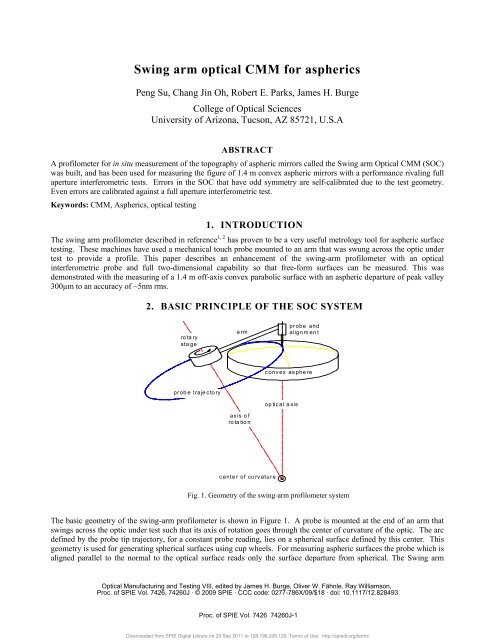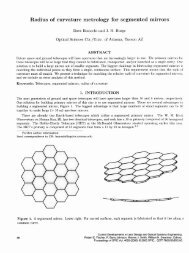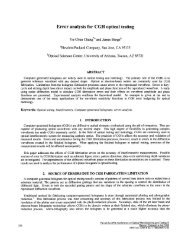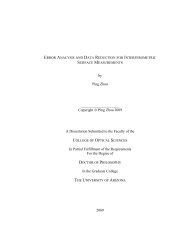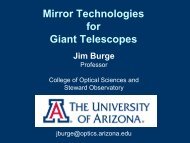Swing arm optical CMM for aspherics - LOFT, Large Optics ...
Swing arm optical CMM for aspherics - LOFT, Large Optics ...
Swing arm optical CMM for aspherics - LOFT, Large Optics ...
You also want an ePaper? Increase the reach of your titles
YUMPU automatically turns print PDFs into web optimized ePapers that Google loves.
<strong>Swing</strong> <strong>arm</strong> <strong>optical</strong> <strong>CMM</strong> <strong>for</strong> <strong>aspherics</strong><br />
Peng Su, Chang Jin Oh, Robert E. Parks, James H. Burge<br />
College of Optical Sciences<br />
University of Arizona, Tucson, AZ 85721, U.S.A<br />
ABSTRACT<br />
A profilometer <strong>for</strong> in situ measurement of the topography of aspheric mirrors called the <strong>Swing</strong> <strong>arm</strong> Optical <strong>CMM</strong> (SOC)<br />
was built, and has been used <strong>for</strong> measuring the figure of 1.4 m convex aspheric mirrors with a per<strong>for</strong>mance rivaling full<br />
aperture interferometric tests. Errors in the SOC that have odd symmetry are self-calibrated due to the test geometry.<br />
Even errors are calibrated against a full aperture interferometric test.<br />
Keywords: <strong>CMM</strong>, Aspherics, <strong>optical</strong> testing<br />
1. INTRODUCTION<br />
The swing <strong>arm</strong> profilometer described in reference 1, 2 has proven to be a very useful metrology tool <strong>for</strong> aspheric surface<br />
testing. These machines have used a mechanical touch probe mounted to an <strong>arm</strong> that was swung across the optic under<br />
test to provide a profile. This paper describes an enhancement of the swing-<strong>arm</strong> profilometer with an <strong>optical</strong><br />
interferometric probe and full two-dimensional capability so that free-<strong>for</strong>m surfaces can be measured. This was<br />
demonstrated with the measuring of a 1.4 m off-axis convex parabolic surface with an aspheric departure of peak valley<br />
300µm to an accuracy of ~5nm rms.<br />
2. BASIC PRINCIPLE OF THE SOC SYSTEM<br />
ro ta ry<br />
sta ge<br />
<strong>arm</strong><br />
probe and<br />
alignm en t<br />
convex asphere<br />
probe trajectory<br />
axis of<br />
ro ta tio n<br />
op tical axis<br />
center of curvature<br />
Fig. 1. Geometry of the swing-<strong>arm</strong> profilometer system<br />
The basic geometry of the swing-<strong>arm</strong> profilometer is shown in Figure 1. A probe is mounted at the end of an <strong>arm</strong> that<br />
swings across the optic under test such that its axis of rotation goes through the center of curvature of the optic. The arc<br />
defined by the probe tip trajectory, <strong>for</strong> a constant probe reading, lies on a spherical surface defined by this center. This<br />
geometry is used <strong>for</strong> generating spherical surfaces using cup wheels. For measuring aspheric surfaces the probe which is<br />
aligned parallel to the normal to the <strong>optical</strong> surface reads only the surface departure from spherical. The <strong>Swing</strong> <strong>arm</strong><br />
Optical Manufacturing and Testing VIII, edited by James H. Burge, Oliver W. Fähnle, Ray Williamson,<br />
Proc. of SPIE Vol. 7426, 74260J · © 2009 SPIE · CCC code: 0277-786X/09/$18 · doi: 10.1117/12.828493<br />
Proc. of SPIE Vol. 7426 74260J-1<br />
Downloaded from SPIE Digital Library on 29 Sep 2011 to 128.196.206.125. Terms of Use: http://spiedl.org/terms
Optical <strong>CMM</strong> (SOC) uses this simple geometry with an <strong>optical</strong>, non-contact interferometric probe that measures<br />
continuously across the optic. The swing <strong>arm</strong> geometry works <strong>for</strong> convex, concave and plane parts. For measuring<br />
concave parts, the scan angle need only be tilted towards the optic, rather than away from the optic as shown <strong>for</strong> the<br />
convex measurements. In our shop, the SOC is rigidly mounted to a computer controlled polishing machine to allow in<br />
situ measurements while the mirror is on the polishing table as shown in Fig. 2.<br />
Fig. 2. SOC in situ measuring a 1.4-m convex off-axis parabolic mirror. Polishing head in back.<br />
Fig. 3. SOC profiling pattern used <strong>for</strong> measuring the 1.4m convex asphere, coordinates units are mm<br />
Fig. 3 shows the profiling pattern we used <strong>for</strong> measuring the 1.4m off-axis parabola (OAP). To be able to well sample<br />
the high frequency structure in the mirror, the SOC makes 64 scans across the mirror, one arc every 5.625º in azimuth.<br />
Since the arcs cross each other at eleven radial positions as the sensor scans the mirror edge to edge, we know the surface<br />
Proc. of SPIE Vol. 7426 74260J-2<br />
Downloaded from SPIE Digital Library on 29 Sep 2011 to 128.196.206.125. Terms of Use: http://spiedl.org/terms
heights must be the same at these scan crossings. This crossing height in<strong>for</strong>mation is used to stitch the scans into a<br />
surface with Maximum likelihood reconstruction method 3, 4 .<br />
3. ALIGNMENT AND CALIBRATION OF THE SOC<br />
The SOC system needs to be aligned so that the rotation axis passes through the nominal center curvature of the optic<br />
under test to minimize the measurement dynamic range. Also, the probe position relative to the test optic needs to be<br />
well known to be able to accurately reconstruct the topography of the test surface.<br />
3.1 Alignment of the SOC<br />
A coordinate system is set up using a laser tracker 5 with the OAP center as the origin and a surface normal at the center<br />
as the z-axis. The x-axis joins the parent vertex to the OAP center. There are three laser tracker balls mounted to the<br />
probe mount. By rotating the <strong>arm</strong> and reading out the tracker ball positions, the <strong>arm</strong> length and rotation axis angle can be<br />
calculated in the OAP coordinate system. The 2-axis stage (elevation and azimuthal) that supports the SOC air bearing is<br />
adjusted so that the rotation axis of the SOC passes through the center curvature of the mirror to null tilt and power from<br />
the SOC scan. By iteratively scanning the surface and making adjustments, the SOC is aligned to minimize the probe<br />
readout to find a best-fit sphere to the OAP. There is no intrinsic error from the alignment because the data reduction<br />
process fully removes this 4 . The probe is aligned normal to the surface at the center of the OAP so that the probe will<br />
measure the aspheric departure normal to the surface.<br />
3.2 Determine probe coordinates<br />
A laser tracker and a PSM 6 are used to calibrate the probe tip coordinates relative to the three tracker balls mounted<br />
around it. After that a calibration between the tip coordinate and the swing <strong>arm</strong> bearing encoder readout is per<strong>for</strong>med.<br />
During a test only the encoder data and table angle are needed to find the probe tip in mirror coordinate system. After<br />
getting the probe tip coordinate from encoder data, the measurement positions on the mirror during the scan can be<br />
calculated with a simple ray tracing algorithm based on the mirror parameters.<br />
3.3 Calibration of repeatable errors in the SOC 4<br />
Errors with odd symmetry: 0.023 µm rms<br />
Errors with even symmetry: 0.025 µm rms<br />
Calibrated<br />
measurement<br />
error in µm<br />
Normalized position on mirror<br />
Normalized position on mirror<br />
Fig. 4. (left) SOC errors with odd symmetry, with 0.023 µm rms magnitude. (right) errors with even symmetry, showing<br />
0.025 µm rms.<br />
As with any function, measurement errors in a single scan from SOC system can be divided into odd and even parts.<br />
From the scan pattern shown in Fig. 3 we know that if all the scan data at different angles are averaged together, the odd<br />
part due to the mirror will be zero, so the odd part of the average of the scans are entirely due to the odd errors in the<br />
SOC. In this way, odd errors can be calibrated and removed during the data reduction.<br />
Calibration data collected at different time, while the mirror was kept being polished, showed that the errors in SOC<br />
system had a repeatability ~1nm rms. Fig 4 (left) shows an estimate of the odd error in our SOC system (low order linear<br />
Proc. of SPIE Vol. 7426 74260J-3<br />
Downloaded from SPIE Digital Library on 29 Sep 2011 to 128.196.206.125. Terms of Use: http://spiedl.org/terms
and cubic terms are removed). Currently, the even errors of SOC system are removed by calibration against an<br />
independent full aperture interferometric test. Fig.4 (right) shows the even errors in our SOC system (quadratic error<br />
removed).<br />
4. SOC DATA REDUCTION AND TEST RESULT FOR AN OAP<br />
An off-axis 1.4m convex parabola with 300 um aspheric departures was fabricated using the SOC system as the main<br />
method of metrology. During a test the OAP was scanned in 64 equally spaced arcs. Each arc was scanned 8 times. The<br />
data were then stitched together using a maximum likelihood reconstruction algorithm 3 that removes alignment errors.<br />
Fig 5(a) shows an example of the raw data from a single scan. Fig 5 (b) shows the data with alignment errors removed.<br />
Eight data sets are collected counting <strong>for</strong>ward and backward scans at a single mirror angle during the test. Fig 5 (c)<br />
shows the difference of a single <strong>for</strong>ward scan data set from the average of that set of <strong>for</strong>ward scan data; 6 nm rms is the<br />
value. Considering a total of eight scans are used <strong>for</strong> calculating a single mirror angle data set, the data <strong>for</strong> stitching at<br />
different mirror angles has a noise level of ~2nm rms.<br />
150<br />
data with alignment errors<br />
5<br />
individal scans<br />
100<br />
4<br />
50<br />
3<br />
probe data (um)<br />
0<br />
-50<br />
-100<br />
-150<br />
-200<br />
um<br />
2<br />
1<br />
0<br />
-1<br />
-250<br />
-50 -40 -30 -20 -10 0 10 20<br />
encoder data (degrees)<br />
-2<br />
-50 -40 -30 -20 -10 0 10 20<br />
encoder angle<br />
(a)<br />
(b)<br />
0.02<br />
rms=6nm<br />
0.015<br />
0.01<br />
Surface<br />
measurement<br />
in µm<br />
0.005<br />
0<br />
-0.005<br />
-0.01<br />
-0.015<br />
-0.02<br />
-50 -40 -30 -20 -10 0 10 20<br />
Encoder angle in degrees<br />
Fig. 5. (a) Single scan of raw data, (b) scan data with alignment term removed, (c) departure of single scan from mean of<br />
data set<br />
(c)<br />
Proc. of SPIE Vol. 7426 74260J-4<br />
Downloaded from SPIE Digital Library on 29 Sep 2011 to 128.196.206.125. Terms of Use: http://spiedl.org/terms
4.1 Surface maps derived from the scan data<br />
The data reduction program produces a surface map which is the departure from the ideal shape of the mirror. Fig 6<br />
shows a comparison of the OAP test results from the SOC and the interferometric null test with astigmatism, coma and<br />
trefoil removed from both tests (there are uncertainties of these three kinds of aberrations in the interferometric test due<br />
to the test alignment). A direct subtraction of the maps shows a difference of ~ 9nm.<br />
Fizeau=0.0357<br />
SOC=0.0356<br />
20<br />
40<br />
0.2<br />
0.15<br />
20<br />
40<br />
0.1<br />
60<br />
0.1<br />
60<br />
0.05<br />
80<br />
100<br />
120<br />
140<br />
0.05<br />
0<br />
-0.05<br />
80<br />
100<br />
120<br />
140<br />
0<br />
-0.05<br />
160<br />
-0.1<br />
160<br />
-0.1<br />
180<br />
180<br />
200<br />
50 100 150 200<br />
-0.15<br />
200<br />
50 100 150 200<br />
(a)<br />
(b)<br />
20<br />
40<br />
60<br />
80<br />
100<br />
120<br />
140<br />
160<br />
180<br />
200<br />
differecne=0.0094<br />
50 100 150 200<br />
(c)<br />
0.1<br />
0.05<br />
0<br />
-0.05<br />
-0.1<br />
Fig. 6 Comparison of the interferometric Fizeau test data (a) and SOC data (b) with tilt, power, coma, astigmatism and<br />
trefoil removed. The direct subtraction (c) shows only 9 nm rms<br />
Proc. of SPIE Vol. 7426 74260J-5<br />
Downloaded from SPIE Digital Library on 29 Sep 2011 to 128.196.206.125. Terms of Use: http://spiedl.org/terms
Fig. 7 shows a comparison of the high frequency in<strong>for</strong>mation in the same data with the 43 lowest orders Zernike terms<br />
removed. The difference is ~8nm.<br />
Fizeau=0.0118<br />
SOC=0.008<br />
0.2<br />
20<br />
40<br />
0.15<br />
20<br />
40<br />
0.04<br />
60<br />
0.1<br />
60<br />
0.02<br />
80<br />
0.05<br />
80<br />
100<br />
120<br />
140<br />
0<br />
-0.05<br />
100<br />
120<br />
140<br />
0<br />
-0.02<br />
160<br />
-0.1<br />
160<br />
-0.04<br />
180<br />
200<br />
50 100 150 200<br />
-0.15<br />
180<br />
200<br />
50 100 150 200<br />
-0.06<br />
(a)<br />
(b)<br />
0.00786445<br />
20<br />
0.2<br />
40<br />
60<br />
80<br />
0.15<br />
0.1<br />
100<br />
0.05<br />
120<br />
0<br />
140<br />
-0.05<br />
160<br />
180<br />
200<br />
50 100 150 200<br />
-0.1<br />
-0.15<br />
(c)<br />
Fig.7. Comparison of the interferometric Fizeau test data (a), SOC data (b) and difference (c) with 43 low order Zernike<br />
aberration terms removed.<br />
Proc. of SPIE Vol. 7426 74260J-6<br />
Downloaded from SPIE Digital Library on 29 Sep 2011 to 128.196.206.125. Terms of Use: http://spiedl.org/terms
Fig. 8 shows a second set of data when the mirror closed to be finished. 43 low order Zernike terms are removed <strong>for</strong> the<br />
comparison of the high frequency in<strong>for</strong>mation in the data. The difference is ~5nm rms, better than the difference data<br />
shown above since more careful interferometric data was taken to beat down the measurement noise. This difference<br />
map is dominated by ghost fringes and known errors in the fold flat in the Fizeau test.<br />
Fizeau 0.0085 um<br />
SOC rms= 0.0062um<br />
20<br />
0.06<br />
20<br />
0.06<br />
40<br />
60<br />
0.04<br />
40<br />
60<br />
0.04<br />
80<br />
0.02<br />
80<br />
0.02<br />
100<br />
120<br />
0<br />
100<br />
120<br />
0<br />
140<br />
-0.02<br />
140<br />
-0.02<br />
160<br />
180<br />
-0.04<br />
160<br />
180<br />
-0.04<br />
200<br />
50 100 150 200<br />
(a)<br />
200<br />
Differnce rms=0.0052um<br />
50 100 150 200<br />
(b)<br />
20<br />
40<br />
60<br />
80<br />
100<br />
120<br />
140<br />
160<br />
180<br />
0.08<br />
0.06<br />
0.04<br />
0.02<br />
0<br />
-0.02<br />
-0.04<br />
200<br />
50 100 150 200<br />
-0.06<br />
(c)<br />
Fig. 8. Comparison of the final interferometric Fizeau test (a), the final SOC data (b) and the difference (c) with the 43 low<br />
order Zernike terms removed.<br />
Proc. of SPIE Vol. 7426 74260J-7<br />
Downloaded from SPIE Digital Library on 29 Sep 2011 to 128.196.206.125. Terms of Use: http://spiedl.org/terms
Given a noise floor <strong>for</strong> the SOC data of ~2 nm rms as estimated from single scan data and comparisons with the Fizeau<br />
data, an accuracy of better than 5 nm rms is a reasonable estimate <strong>for</strong> the per<strong>for</strong>mance of the SOC system.<br />
5. SUMMARY<br />
A profilometer (SOC) <strong>for</strong> in situ measurement of the topography of aspheric mirrors was developed at University of<br />
Arizona, and has been used <strong>for</strong> measuring the figure of 1.4 m mirrors with a per<strong>for</strong>mance rivaling full aperture<br />
interferometric tests. The SOC adopts swing-<strong>arm</strong> geometry that is a spherical coordinate system, is especially good at<br />
testing <strong>optical</strong> elements since most of the interests are the departures from spheres. Only the radial scan motion needs to<br />
be well controlled that is a simplification comparing with Cartesian coordinate system <strong>CMM</strong>. Further development<br />
would add increased internal metrology, allowing complete self-calibration can be obtained <strong>for</strong> SOC. 4<br />
REFERENCES<br />
[1]<br />
[2]<br />
[3]<br />
[4]<br />
[5]<br />
[6]<br />
David S. Anderson, Robert E. Parks, and T. Shao, “A versatile profilometer <strong>for</strong> the measurement of <strong>aspherics</strong>,”<br />
OF&T Workshop Technical Digest, Monterrey, CA (1990).<br />
David S. Anderson and James H. Burge, <strong>Swing</strong>-<strong>arm</strong> profilometry of <strong>aspherics</strong>, Proc. SPIE. 2536, 169-179 (1995).<br />
Peng Su, James H. Burge, Robert A. Sprowl, Jose Sasian, “Maximum likelihood estimation as a general method of<br />
combining sub-aperture data <strong>for</strong> interferometric test,” Proc. SPIE. 6342, 63421x-1-63421x-6 (2006).<br />
Peng Su, Chang Jin Oh, Robert E. Parks, James H. Burge, “<strong>Swing</strong> <strong>arm</strong> <strong>optical</strong> <strong>CMM</strong>,” to be submitted to Applied<br />
<strong>Optics</strong> (2009).<br />
James H. Burge, Peng Su, Chunyu Zhao, Tom Zobrist, “Use of a commercial laser tracker <strong>for</strong> <strong>optical</strong> alignment,”<br />
Proc. SPIE. 6676, 66760E (2007).<br />
Robert E. Parks, Versatile Auto-stigmatic Microscope. Proc. SPIE. 6290, 62890J (2006).<br />
Proc. of SPIE Vol. 7426 74260J-8<br />
Downloaded from SPIE Digital Library on 29 Sep 2011 to 128.196.206.125. Terms of Use: http://spiedl.org/terms


